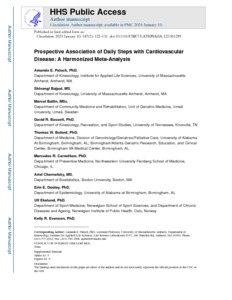Paluch, AE;
Bajpai, S;
Ballin, M;
Bassett, DR;
Buford, TW;
Carnethon, MR;
Chernofsky, A;
Dooley, EE;
Ekelund, U;
Evenson, KR;
et al.
Paluch, AE; Bajpai, S; Ballin, M; Bassett, DR; Buford, TW; Carnethon, MR; Chernofsky, A; Dooley, EE; Ekelund, U; Evenson, KR; Galuska, DA; Jefferis, BJ; Kong, L; Kraus, WE; Larson, MG; Lee, I-M; Matthews, CE; Newton, RL; Nordström, A; Nordström, P; Palta, P; Patel, AV; Pettee Gabriel, K; Pieper, CF; Pompeii, L; Rees-Punia, E; Spartano, NL; Vasan, RS; Whincup, PH; Yang, S; Fulton, JE; Steps for Health Collaborative
(2023)
Prospective Association of Daily Steps With Cardiovascular Disease: A Harmonized Meta-Analysis.
Circulation, 147 (2).
pp. 122-131.
ISSN 1524-4539
https://doi.org/10.1161/CIRCULATIONAHA.122.061288
SGUL Authors: Whincup, Peter Hynes
![[img]](https://openaccess.sgul.ac.uk/116279/1.hassmallThumbnailVersion/Prospective%20Association%20of%20Daily%20Steps%20With%20Cardiovascular%20Disease%20A%20Harmonized%20Meta-Analysis.pdf)  Preview |
|
PDF
Accepted Version
Available under License ["licenses_description_publisher" not defined].
Download (951kB)
| Preview
|
Abstract
BACKGROUND: Taking fewer than the widely promoted "10 000 steps per day" has recently been associated with lower risk of all-cause mortality. The relationship of steps and cardiovascular disease (CVD) risk remains poorly described. A meta-analysis examining the dose-response relationship between steps per day and CVD can help inform clinical and public health guidelines. METHODS: Eight prospective studies (20 152 adults [ie, ≥18 years of age]) were included with device-measured steps and participants followed for CVD events. Studies quantified steps per day and CVD events were defined as fatal and nonfatal coronary heart disease, stroke, and heart failure. Cox proportional hazards regression analyses were completed using study-specific quartiles and hazard ratios (HR) and 95% CI were meta-analyzed with inverse-variance-weighted random effects models. RESULTS: The mean age of participants was 63.2±12.4 years and 52% were women. The mean follow-up was 6.2 years (123 209 person-years), with a total of 1523 CVD events (12.4 per 1000 participant-years) reported. There was a significant difference in the association of steps per day and CVD between older (ie, ≥60 years of age) and younger adults (ie, <60 years of age). For older adults, the HR for quartile 2 was 0.80 (95% CI, 0.69 to 0.93), 0.62 for quartile 3 (95% CI, 0.52 to 0.74), and 0.51 for quartile 4 (95% CI, 0.41 to 0.63) compared with the lowest quartile. For younger adults, the HR for quartile 2 was 0.79 (95% CI, 0.46 to 1.35), 0.90 for quartile 3 (95% CI, 0.64 to 1.25), and 0.95 for quartile 4 (95% CI, 0.61 to 1.48) compared with the lowest quartile. Restricted cubic splines demonstrated a nonlinear association whereby more steps were associated with decreased risk of CVD among older adults. CONCLUSIONS: For older adults, taking more daily steps was associated with a progressively decreased risk of CVD. Monitoring and promoting steps per day is a simple metric for clinician-patient communication and population health to reduce the risk of CVD.
| Item Type: |
Article
|
| Additional Information: |
This is a non-final version of an article published in final form in Paluch, AE; Bajpai, S; Ballin, M; Bassett, DR; Buford, TW; Carnethon, MR; Chernofsky, A; Dooley, EE; Ekelund, U; Evenson, KR; et al. (2023) Prospective Association of Daily Steps With Cardiovascular Disease: A Harmonized Meta-Analysis. Circulation, 147 (2). pp. 122-131. |
| Keywords: |
cardiovascular disease, exercise, public health, risk reduction behavior, Humans, Female, Aged, Middle Aged, Male, Cardiovascular Diseases, Prospective Studies, Risk Factors, Heart Failure, Coronary Disease, Steps for Health Collaborative, Humans, Cardiovascular Diseases, Coronary Disease, Risk Factors, Prospective Studies, Aged, Middle Aged, Female, Male, Heart Failure, cardiovascular disease, exercise, public health, risk reduction behavior, Aged, Cardiovascular Diseases, Coronary Disease, Female, Heart Failure, Humans, Male, Middle Aged, Prospective Studies, Risk Factors, cardiovascular disease, exercise, public health, risk reduction behavior, 1102 Cardiorespiratory Medicine and Haematology, 1103 Clinical Sciences, 1117 Public Health and Health Services, Cardiovascular System & Hematology |
| SGUL Research Institute / Research Centre: |
Academic Structure > Population Health Research Institute (INPH) |
| Journal or Publication Title: |
Circulation |
| ISSN: |
1524-4539 |
| Language: |
eng |
| Dates: |
| Date | Event |
|---|
| 10 January 2023 | Published | | 20 December 2022 | Published Online | | 20 October 2022 | Accepted |
|
| Publisher License: |
Publisher's own licence |
| Projects: |
|
| PubMed ID: |
36537288 |
| Web of Science ID: |
WOS:000918503500006 |
 |
Go to PubMed abstract |
| URI: |
https://openaccess.sgul.ac.uk/id/eprint/116279 |
| Publisher's version: |
https://doi.org/10.1161/CIRCULATIONAHA.122.061288 |
Statistics
Item downloaded times since 11 Mar 2024.
Actions (login required)
 |
Edit Item |



